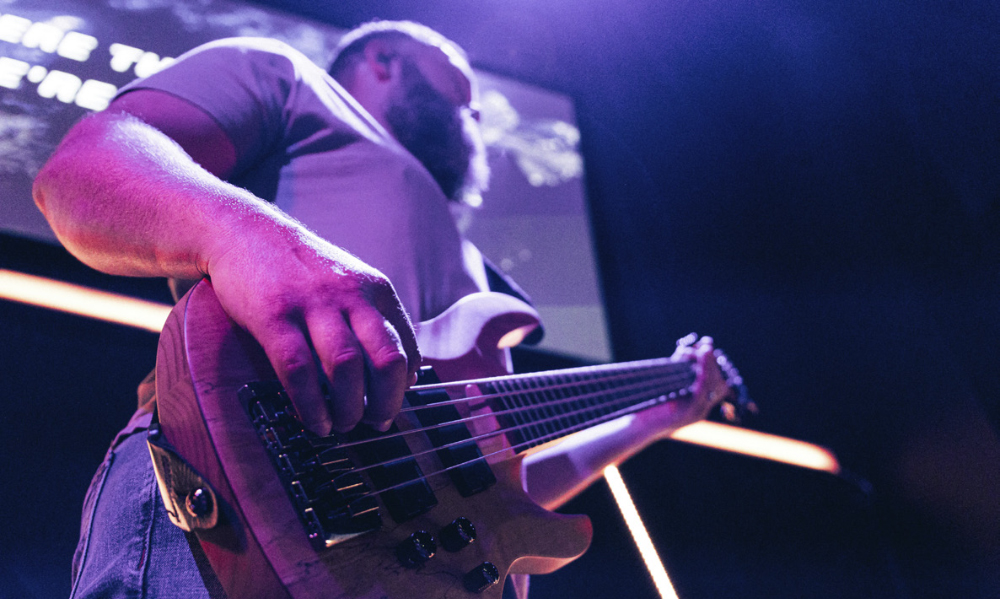A while back, an attendee of one of my workshops e-mailed about problems he’s having in providing a bass guitar mix over a personal monitoring system utilized by a four-piece band, all of whom wear in-ear monitors (IEMs).
The system has one transmitter feeding four receivers, receiving a simple split-track mix with all vocals on one channel and all instruments on the second channel. (Note that the bassist is plugging directly into the snake via an active DI box without any amplifier or processor on stage.)
The band is complaining that the bass guitar sounds “fuzzy” in all of their IEMs. Here are some recommendations. –
— Check to make sure the instrument output isn’t overdriving the input of the active DI box. If the bass sounds fuzzy or distorted in the PA, or while soloing that channel on the console with headphones, then engage the 20 dB pad. Active DI boxes (and yes, passive models as well) can be overdriven and distorted by active guitar pickups. Monitor for this at the console with a good set of headphones.
— Many bass guitarists play quite aggressively (pop and slap), which usually is compressed and limited by their on-stage amplifiers or processors. However, a direct connection into a DI (passive or active) doesn’t round off these dynamic peaks, which can cause distorted or fuzzy sound anywhere in the signal chain that doesn’t have sufficient headroom to deal with it. Integrating a Line 6 Bass POD or SansAmp bass module can provide an elegant solution.
— IEMs sometimes can’t generate enough low-end energy for bassists to monitor themselves properly. If there’s a lot of bass leaking back to the stage from a loud PA, then the IEMs can provide the mid-high frequency detail. But with a nice 85-90 dB SPL mix in the room, there may not be enough bass for the player to “feel” what he/she is playing.
A solution can be adding a low-frequency “thumper/shaker” such as a ButtKicker Concert or a TST429 Platinum from Clark Synthesis, which can be mounted on a small platform for the player to stand on. The result: instant bass that’s felt without anyone else hearing it.
Also, a very small bass amp with a direct out might be a good idea, as long as the volume level is kept to a low roar. Any small practice amp should do the trick; let the main PA make bass for the room.
— Combining everyone’s personal monitoring into a common transmitter that feeds multiple receivers is less expensive but it’s also a lot less “personal.” This approach can work when everyone needs a similar mix (multiple backup singers, for instance), but it’s generally not a good idea with IEMs fed by wildly different instruments. Just as is usually the case with floor monitors, each person/player wants to hear his/her own instrument predominantly, plus a lower-level mix of what’s needed for cueing.
It’s better to utilize individual channels or transmitters so each player can receive a tailored, custom mix. SPL levels in the IEMs should be much lower for each person, and without overdriving the transducers within the earpieces as players try to hear what they’re playing over what everyone else is playing.
This also holds true for floor wedges. Supplying independent mixes on six different wedges will end up being much lower in volume in the long run since each artist gets to hear primarily themselves plus a few cue instruments. With the recent advent of many options of powered wedges available, this is considerably more cost effective than it used to be.
—Finally, be aware that it’s very dangerous for musicians to wear only one earpiece on a loud stage. It’s very difficult to hear how loud the SPL level is coming into the one ear via the earpiece while the other ear listens to the band. Artists cranking it up in only the one earpiece can do extensive hearing damage in a short amount of time.
In fact, some monitor engineers won’t run sound for anyone who insists on using only one earpiece for fear of a lawsuit if the artist goes deaf. So be very careful if anyone in a band you’re working with wants to try this sort of thing.




















